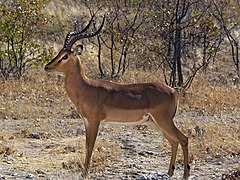Impale
| Aepycerotini | |||
| J.E. Gray, 1872 | |||
 Przedstawiciel plemienia – impala czarnolica (A. petersi) | |||
| Systematyka | |||
| Domena | |||
|---|---|---|---|
| Królestwo | |||
| Gromada | |||
| Podgromada | |||
| Infragromada | |||
| Rząd | |||
| Podrząd | |||
| Infrarząd | |||
| Rodzina | |||
| Podrodzina | |||
| Plemię |
impale | ||
| Typ nomenklatoryczny | |||
|
Plemię:Aepyceros Sundevall, 1847 | |||
| Synonimy | |||
| |||
| Rodzaje i Gatunki | |||
| |||
Impale[10] (Aepycerotini) – monotypowe plemię ssaków z podrodziny antylop (Antilopinae) w obrębie rodziny wołowatych (Bovidae).
Zasięg występowania[edytuj | edytuj kod]
Plemię obejmuje jeden współcześnie żyjacy gatunek występujący we wschodniej i południowej Afryce[11][12][13].
Morfologia[edytuj | edytuj kod]
Długość ciała 125–135 cm, długość ogona 25–35 cm, wysokość w kłębie 90–98 cm; masa ciała 43–64 kg[12]. Wzór zębowy: I C P M (x2) = 40[12].
Systematyka[edytuj | edytuj kod]
Rodzaj zdefiniował w 1847 roku szwedzki zoolog Carl Jakob Sundevall w artykule poświęconym przeżuwaczom opublikowanym na łamach Kungliga Svenska Vetenskapsakademiens Handlingar[9]. Na gatunek typowy Sundevall wyznaczył (oznaczenie monotypowe) impalę zwyczajną (A. melampus).
Etymologia[edytuj | edytuj kod]
Aepyceros (Aepiceras, Aepyceras): gr. αιπυς aipus ‘wysoki’; κερας keras, κερατος keratos ‘róg’[14].
Podział systematyczny[edytuj | edytuj kod]
Aepycerotini jest uważana za jedną z najstarszych gałęzi ewolucyjnych wołowatych. Szczątki impali znane są z zapisów kopalnych datowanych na 6,5 mln lat, a ich budowa nie różni się zasadniczo od współczesnego przedstawiciela rodzaju. Do plemienia należy jeden rodzaj impala[10] (Aepyceros) wraz w zależności od ujęcia systematycznego jednym (A. melampus) lub dwoma gatunkami (A. petersi i A. melampus)[11][12]; tutaj klasyfikacja z jednym występującym współcześnie gatunkiem za Mammals Diversity Database i All the Mammals of the World (2023)[15][16][10]:
- Aepyceros melampus (H. Lichtenstein, 1812) – impala zwyczajna
Opisano również kilka gatunków wymarłych z terenów Afryki:
- Aepyceros afarensis Geraads, Melillo & Haile-Selassie, 2009[17] (pliocen)
- Aepyceros datoadeni Geraads, Bobe & Reed, 2012[18] (pliocen)
- Aepyceros dietrichi Gentry, 2011[19] (pliocen-plejstocen)
- Aepyceros shungurae Gentry, 1985[20] (pliocen)
Uwagi[edytuj | edytuj kod]
Przypisy[edytuj | edytuj kod]
- ↑ J.E. Gray: Catalogue of ruminant Mammalia (Pecora, Linnaeus) in the British Museum. London: British Museum, 1872, s. 4, 42. (ang.).
- ↑ R.I. Pocock. On the Specialized Cutaneous Glands of Ruminants. „Proceedings of the Zoological Society of London”. 1910, s. 847, 1910. (ang.).
- ↑ R. Lydekker & G. Blaine: Catalogue of the Ungulate Mammals in the British Museum (Natural History). Cz. 3: Artiodactyla, Family Bovidæ, Subfamilies Aepycerotinæ to Tragelaphinæ (Pala, Saiga, Gazelles, Oryx Group, Bushbucks, Kudus, Elands, Etc.), Antilocapridæ (Prongbuck), and Giraffidæ (Giraffes and Okapi). London: Printed by order of the Trustees, 1914, s. vii, 4. (ang.).
- ↑ T. Haltenorth: Klassifikation der Säugetiere: Artiodactyla. W: E. Thenius (red.): Handbuch der Zoologie. Cz. 8: Mammalia. Berlin: W. de Gruyter, 1963, s. 96. (niem.).
- ↑ G.E. Pilgrim. The fossil Bovidae of India. „Memoirs of the Geological Survey of India, Palaeontologia Indica”. 26, s. 23, 1939. (ang.).
- ↑ L.S.B. Leakey: Mammalian fauna: Bovidae. W: L.S.B. Leakey: Olduvai Gorge 1951-61. Cz. 1: Fauna and Background. Cambridge: Cambridge University Press, 1965, s. 65. (ang.).
- ↑ K.A. von Zittel: Handbuch der palaeontologie. Cz. 4. München: R. Oldenbourg, 1893, s. 417. (niem.).
- ↑ D.G. Elliot. A catalogue of the collection of mammals in the Field Columbian Museum. „Publication. Field Columbian Museum”. Zoological series. 8 (1), s. 71, 1904. (ang.).
- ↑ a b C.J. Sundevall. Methodisk öfversigt af Idislande djuren, Linnes Pecora. „Kungliga Svenska Vetenskapsakademiens Handlingar”. För år 1845, s. 271, 1847. (łac.).
- ↑ a b c Nazwy zwyczajowe za: W. Cichocki, A. Ważna, J. Cichocki, E. Rajska-Jurgiel, A. Jasiński & W. Bogdanowicz: Polskie nazewnictwo ssaków świata. Warszawa: Muzeum i Instytut Zoologii PAN, 2015, s. 177. ISBN 978-83-88147-15-9. (pol. • ang.).
- ↑ a b C.J. Burgin, D.E. Wilson, R.A. Mittermeier, A.B. Rylands, T.E. Lacher & W. Sechrest: Illustrated Checklist of the Mammals of the World. Cz. 2: Eulipotyphla to Carnivora. Barcelona: Lynx Edicions, 2020, s. 332. ISBN 978-84-16728-35-0. (ang.).
- ↑ a b c d C. Groves, D. Leslie, B. Huffman, R. Valdez, K. Habibi, P. Weinberg, J. Burton, P. Jarman & W. Robichaud: Family Bovidae (Hollow-horned Ruminants). W: D.E. Wilson & R.A. Mittermeier (redaktorzy): Handbook of the Mammals of the World. Cz. 2: Hoofed Mammals. Barcelona: Lynx Edicions, 2011, s. 623–625. ISBN 978-84-96553-77-4. (ang.).
- ↑ D.E. Wilson & D.M. Reeder (redaktorzy): Genus Aepyceros. [w:] Mammal Species of the World. A Taxonomic and Geographic Reference (Wyd. 3) [on-line]. Johns Hopkins University Press, 2005. [dostęp 2021-04-23]. (ang.).
- ↑ T.S. Palmer. Index Generum Mammalium: a List of the Genera and Families of Mammals. „North American Fauna”. 23, s. 82, 1904. (ang.).
- ↑ N. Upham, C. Burgin, J. Widness, M. Becker, C. Parker, S. Liphardt, I. Rochon & D. Huckaby: Treeview of Mammalian Taxonomy Hierarchy. [w:] ASM Mammal Diversity Database (Version 1.11) [on-line]. American Society of Mammalogists. [dostęp 2023-11-30]. (ang.).
- ↑ Class Mammalia. W: Lynx Nature Books: All the Mammals of the World. Barcelona: Lynx Edicions, 2023, s. 604. ISBN 978-84-16728-66-4. (ang.).
- ↑ D. Geraads, S. Melillo & Y. Haile-Selassie. Middle Pliocene Bovidae from Hominid-bearing sites in the Woranso-Mille area, Afar region, Ethiopia. „Palaeontologia africana”. 44, s. 66, 2009. (ang.).
- ↑ D. Geraads, R. Bobe & K. Reed. Pliocene Bovidae (Mammalia) from the Hadar Formation of Hadar and Ledi-Geraru, Lower Awash, Ethiopia. „Journal of Vertebrate Paleontology”. 32 (1), s. 191, 2012. DOI: 10.1080/02724634.2012.632046. (ang.).
- ↑ A.W. Gentry: Bovidae. W: T. Harrison (red.): Paleontology and Geology of Laetoli: Human Evolution in Context. Cz. 2: Fossil Hominins and the Associated Fauna. Berlin: Springer, 2011, s. 376. ISBN 978-90-481-9956-3. (ang.).
- ↑ A.W. Gentry: The Bovidae of the Omo Group deposits, Ethiopia. W: Y. Coppens & F.C. Howell (redaktorzy): Les Faunes Plio-Pléistocènes de la Basse Vallée de l’Omo (Ethiope). Cz. 1: Périssodactyles, Artiodactyles (Bovidae). Paris: CNRS, 1985, s. 171. ISBN 978-2-222-03461-2. (fr. • ang.).



